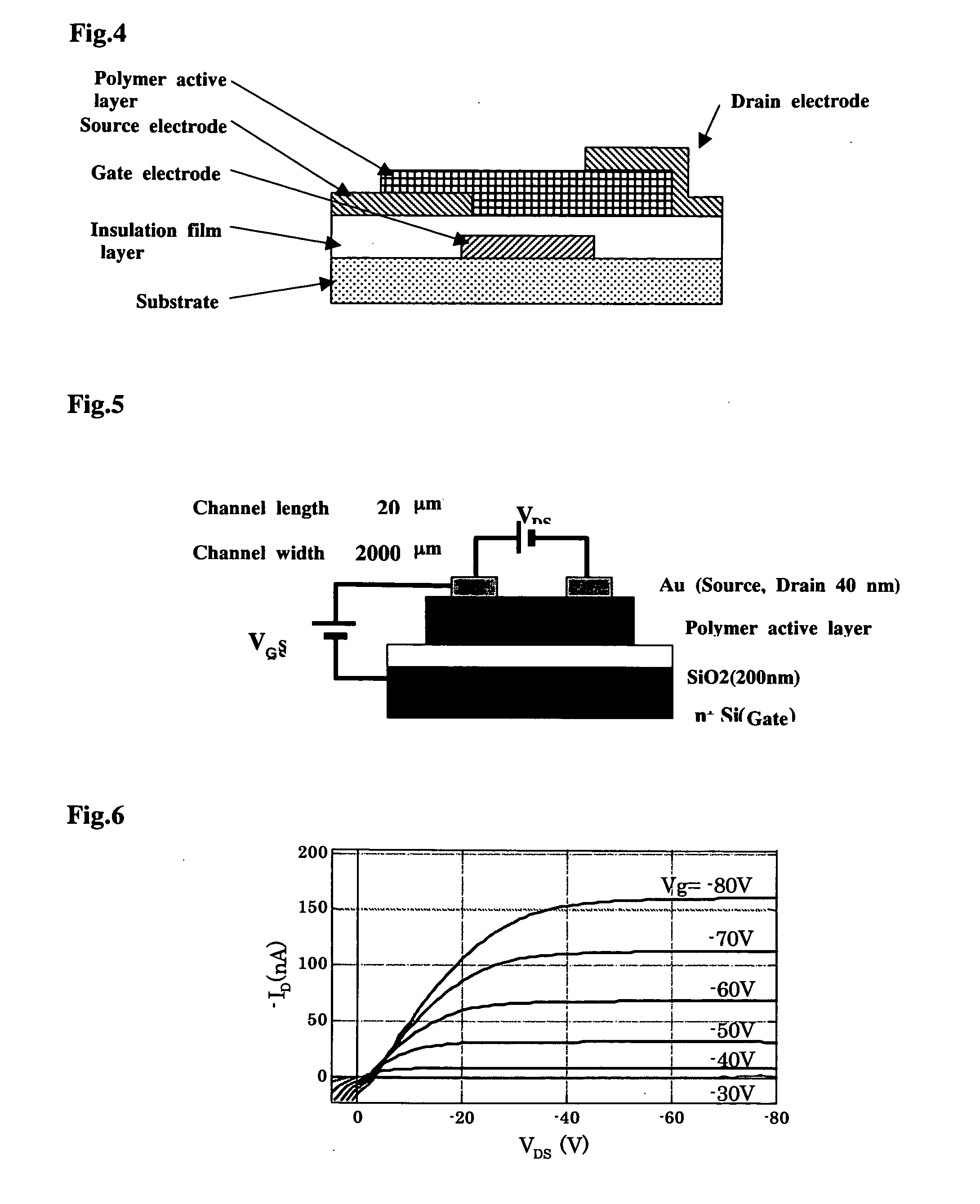Polymer Compound and Polymer Light-Emitting Device Using the Same
- Summary
- Abstract
- Description
- Claims
- Application Information
AI Technical Summary
Benefits of technology
Problems solved by technology
Method used
Image
Examples
synthesis example 1
Synthesis of 1-bromo-4-t-butyl-2,6-dimethylbenzene
[0430]
[0431]Under an inert atmosphere, 225 g of acetic acid was charged in a 500 ml three-necked flask, and 24.3 g of 5-t-butyl-m-xylene was added. Subsequently, 31.2 g of bromine was added, then, the mixture was reacted at 15 to 20° C. for 3 hours.
[0432]The reaction solution was added to 500 ml of water, and the deposited precipitate was filtrated. This was washed with 250 ml of water twice, to obtain 34.2 g of white solid.
[0433]1H-NMR (300 MHz / CDCl3):
[0434]δ (ppm)=1.3 (s, 9H), 2.4 (s, 6H), 7.1 (s, 2H)
[0435]MS (FD+) M+ 241
Synthesis of N,N′-diphenyl-N,N′-bis(4-t-butyl-2,6-dimethylphenyl)-1,4-phenylenediamine
[0436]
[0437]Under an inert atmosphere, 36 ml of dehydrated toluene was charged in a 100 ml three-necked flask, and 0.63 g of tri(t-butyl)phosphine was added. Subsequently, 0.41 g of tris(dibenzylideneacetone)dipalladium, 9.6 g of 1-bromo-4-t-butyl-2,6-dimethylbenzene, 5.2 g of t-butoxysodium, and 4.7 g of N,N′-diphenyl-1,4-phenyle...
synthesis example 2
Synthesis of N,N′-diphenyl-N,N′-bis(4-t-butyl-2,6-dimethylphenyl)-benzidine
[0445]
[0446]Under an inert atmosphere, 1660 ml of dehydrated toluene was charged in a 300 ml three-necked flask, and 275.0 g of N,N′-diphenylbenzidine and 449.0 g of 4-t-butyl-2,6-dimethylbromobenzene were added. Subsequently, 7.48 g of tris(dibenzylideneacetone)dipalladium and 196.4 g of t-butoxysodium were added, then, 5.0 g of tri(t-butyl)phosphine was added. Thereafter, the mixture was reacted at 105° C. for 7 hours.
[0447]2000 ml of toluene was added to the reaction solution, filtrated through cerite, and the filtrate was washed with 1000 ml of water three times, then, concentrated to 700 ml. To this was added 1600 ml of toluene / methanol (1:1) solution, the deposited crystal was filtrated, and washed with methanol. 479.4 g of white solid was obtained.
[0448]MS (APCI (+)): (M+H)+ 657.4
Synthesis of N,N′-bis(4-bromophenyl)-N,N′-bis(4-t-butyl-2,6-dimethylphenyl)-benzidine
[0449]
[0450]Under an inert atmosphere, ...
synthesis example 3
Synthesis of Compound T
(Synthesis of Compound S)
[0453]
[0454]Under an inert atmosphere, 100 ml of dehydrated toluene was charged in a 300 ml three-necked flask, and 16.9 g of diphenylamine and 25.3 g of 1-bromo-4-t-butyl-2,6-dimethylbenzene were added. Subsequently, 0.92 g of tris(dibenzylideneacetone)dipalladium and 12.0 g of t-butoxysodium were added, then, 1.01 g of tri(t-butyl)phosphine was added. Thereafter, the mixture was reacted at 100° C. for 7 hours.
[0455]The reaction solution was poured into a saturated saline solution and extracted with 100 ml of toluene. The toluene layer was washed with dilute hydrochloric acid and saturated saline solution, then, the solvent was distilled off to obtain black solid. This was separated and purified by silica gel column chromatography (hexane / chloroform 9 / 1), to obtain 30.1 g of white solid.
[0456]1H-NMR (300 MHz / CDCl3): δ (ppm)=1.3 (s, 9H), 2.0 (s, 6H), 6.8˜7.3 (m, 10H)
(Synthesis of Compound T)
[0457]
[0458]Under an inert atmosphere, 333 ml...
PUM
| Property | Measurement | Unit |
|---|---|---|
| Viscosity | aaaaa | aaaaa |
| Electric potential / voltage | aaaaa | aaaaa |
| Quantum yield | aaaaa | aaaaa |
Abstract
Description
Claims
Application Information
 Login to View More
Login to View More - R&D
- Intellectual Property
- Life Sciences
- Materials
- Tech Scout
- Unparalleled Data Quality
- Higher Quality Content
- 60% Fewer Hallucinations
Browse by: Latest US Patents, China's latest patents, Technical Efficacy Thesaurus, Application Domain, Technology Topic, Popular Technical Reports.
© 2025 PatSnap. All rights reserved.Legal|Privacy policy|Modern Slavery Act Transparency Statement|Sitemap|About US| Contact US: help@patsnap.com



